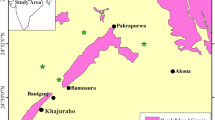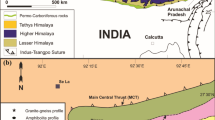Abstract
Geochemical studies in Deccan syneclise have identified anomalous concentration of light hydrocarbon gases in the surface soil from the Tapti rift region in Narmada–Son Lineament, India. We have reanalysed and modelled broadband MT data from this region to delineate basalts and underlying sediment configuration, which is favourable for hydrocarbon accumulation. We carried out 1D and 3D modelling of the MT data for this purpose. Modelling studies brought regions of thick sub-basaltic sediments towards NW and SW of Nepanagar. But very less anomalous light hydrocarbon gas concentration is observed along NW of Nepanagar. This may be due to the presence of thick basalt cover in that area, which prevents the leakage of gaseous hydrocarbons on to the surface soil. We observed a comparatively thin basalt layer and high sediment thickness with a high concentration of light hydrocarbon gases near to Burhanpur area, which strongly suggests better hydrocarbon prospects in the area. It is inferred that the relatively thin and fractured/vesicular nature of basalt in this region facilitates the upward migration of light hydrocarbon components to the surface soil.








Similar content being viewed by others
References
Abdel Zaher M, Nishijima J, Saibi H, El-Qady G, Massoud O, Soliman M, Younis A, Ehara S (2012) A Coastal aquifer study using magnetotelluric and gravity methods in Abo Zenema, Egypt. Pure and Applied Geophysics. 169(9):1679–1692. https://doi.org/10.1007/s00024-011-0407-y
Abdul Azeez KK, Satish Kumar T, Basava S, Harinarayana T, Dayal AM (2011) Hydrocarbon prospects across Narmada–Tapti rift in Deccan trap, central India: inferences from integrated interpretation of magnetotelluric and geochemical prospecting studies. Marine and Petroleum Geology 28:1073–1082. https://doi.org/10.1016/j.marpetgeo.2011.01.003
Abdul Azeez KK, Athul C, Stephan T (2018) Reservoir characterization and basement estimates in the Papuan Fold belt (Papua New Guinea-PNG), from reanalysis of the PNG MT data set. Marine and Petroleum Geology. 98:133–145. https://doi.org/10.1016/j.marpetgeo.2018.08.009
Bahr K (1988) Interpretation of the magnetotelluric impedance tensor—regional induction and local telluric distortion. J Geophys 62(2):119–127
Bibby HM, Caldwell TG, Brown C (2005) Determinable and non-determinable parameters of galvanic distortion in magnetotellurics. Geophysical Journal International. 163:915–930. https://doi.org/10.1111/j.1365-246X.2005.02779.x
Biswas SK (1987) Regional tectonic framework, structure and evolution of the western marginal basins of India. Tectonophysics. 135:307–327. https://doi.org/10.1016/0040-1951(87)90115-6
Biswas SK (1999) A Review on the Evolution of rift basins in India during Gondwana with special reference to Western Indian Basins and their hydrocarbon prospects. Proc Indian Natl Sci Acad 65(Special Issue):261–283
Bois C, Bouche P, Pelet R (1982) Global geologic history and distribution of hydrocarbon reserves. AAPG Bulletin. 66:1248–1270
Caldwell TG, Bibby HM, Brown C (2004) The magnetotelluric phase tensor. Geophysical Journal International. 158:457–469. https://doi.org/10.1111/j.1365-246X.2004.02281.x
Central Ground Water Board MoWR (2013) District ground water information booklet. Burhanpur District, Madhya Pradesh
Choubey VD (1971) Narmada–Son Lineament, India. Nature Physical Science 232:38–40. https://doi.org/10.1038/physci232038a0
Constable SC, Parker RL, Constable CG (1987) Occam's inversion: a practical algorithm for generating smooth models from electromagnetic sounding data. Geophysics. 52:289–300
Ellinghaus A (1997) PROCMT user’s guide, Offline Processing Software for Magnetotelluric Time Series. Vol. 2.1: 1-100
Ghatak S, Ghatak M (2008) Active faulting and its bearing on the geology, drainage and landscape in Tapi Fault Zone. Gond Geol Magz 23(1):31–37
Goldberg S, Rotstein Y (1982) A simple form of presentation of magnetotelluric data using the bostic transform. Geophysical Prospecting. 30:211–216. https://doi.org/10.1111/j.1365-2478.1982.tb01299.x
GSI (2000) Seismotectonic Atlas of India and Its Environs. Geological Survey of India publication
Gupta MC, Singh BK, Singh KN (2011) Engineering geological rock mass classification of Punasa tunnel site, Khandwa District, Madhya Pradesh. J Geol Soc India. 77:269–272. https://doi.org/10.1007/s12594-011-0034-3
Horvitz L (1939) On geochemical prospecting-I. Geophysics. 4:210–228
Kaila KL, Krishna VG, Mall DM (1981) Crustal structure along Mehmadabad-Billimora profile in the Cambay basin, India, from deep seismic soundings. Tectonophysics. 76:99–130. https://doi.org/10.1016/0040-1951(81)90255-9
Kaila KL, Reddy PR, Dixit MM, Rao PK (1985) Crustal structure across the Narmada-Son Lineament, Central India from deep seismic soundings. Geological Society of India. [Sl]: 465-480
Kaila KL, Murthy PRK, Mall DM (1989) The evolution of the Vindhyan basin vis-à-vis the Narmada-Son lineament, central India, from deep seismic soundings. Tectonophysics. 162:277–289. https://doi.org/10.1016/0040-1951(89)90249-7
Kalpana MS, Madhavi T, Mani D, Lakshmi M, Pundaree N, Sujai M, Kavitha S, Devekar AP, Patil DJ, Dayal AM, Haragopal V (2016) Integrated surface geochemical studies for hydrocarbon prospects in Deccan Syneclise, India. Journal of Petroleum Science and Engineering. 147:801–815. https://doi.org/10.1016/j.petrol.2016.09.031
Kerbadj N, Saibi H, A Bouzid, MO Bounif, S Bougchiche (2017) 2-D inversion of magnetotelluric data at Dar-Chioukh region (Djelfa, Algeria). The 4th International Conference on Engineering Geophysics (ICEG), Al-Ain, UAE
Patro PK (2017) Magnetotelluric studies for hydrocarbon and geothermal resources: examples from the Asian Region. Surv Geophys. 38:1005–1041. https://doi.org/10.1007/s10712-017-9439-x
Pedersen J, Hermance J (1986) Least squares inversion of one-dimensional magnetotelluric data: an assessment of procedures employed by Brown University. Surv. Geophys. 8:187–231
Ryan WBF, Carbotte SM, Coplan JO, O'Hara S, Melkonian A, Arko R, Weissel RA, Ferrini V, Goodwillie A, Nitsche F, Bonczkowski J, Zemsky R (2009) Global multi-resolution topography synthesis. Geochem Geophys Geosyst. 10:Q03014. https://doi.org/10.1029/2008GC002332
Singh AP, Meissner R (1995) Crustal configuration of the Narmada-Tapti region (India) from gravity studies. Journal of Geodynamics. 20:111–127. https://doi.org/10.1016/0264-3707(95)00003-R
Siripunvaraporn W, Egbert G, Lenbury Y, Uyeshima M (2005) Three-dimensional magnetotelluric inversion: data-space method. Phys. Earth Planet. Inter. 150:3–14. https://doi.org/10.1016/j.pepi.2004.08.023
Swift CM (1967) Magnetotelluric Investigation of an Electrical Conductivity Anomaly in the Southwestern United States. [PhD thesis, Massachusetts Institute of Technology, MA, USA]
Tissot BP, Welte DH (1984) Petroleum formation and occurrence, 2nd edn. Springer-Verlag, Berlin Heidelberg. https://doi.org/10.1007/978-3-642-87813-8
Unsworth M (2005) New developments in conventional hydrocarbon exploration with electromagnetic methods. CSEG Recorder. 30:35–39
Verma RK, Banerjee P (1992) Nature of continental crust along the Narmada—Son Lineament inferred from gravity and deep seismic sounding data. Tectonophysics. 202:375–397. https://doi.org/10.1016/0040-1951(92)90121-L
Wadia D (1975) Geology of India. Tata Mc Graw-Hills Publishing Co, New Delhi
West WD (1962) The Line of Narmada and Son Valleys. Current Science. 31:143–144
Yilmaz O (2001) Seismic data analysis, processing, inversion and interpretation of seismic data. Investigations in Geophysics. No. 10: Vol 2. Society of Exploration Geophysicists
Acknowledgments
We thank the Director, CSIR-NGRI, for giving permission to publish this work. All colleagues from Magnetotellurics Division, CSIR-NGRI, especially the crew members, acquired the field data are gratefully acknowledged. The comments from both the reviewers and the editor have improved the clarity in the manuscript.
Funding
Research of KSA, PKP, KKAA, and KV was funded through the projects MLP-6404-28 (BPK) and MLP-0001-28-FBR-1.
Author information
Authors and Affiliations
Corresponding author
Additional information
Responsible Editor: Narasimman Sundararajan
Rights and permissions
About this article
Cite this article
Ajithabh, K.S., Patro, P.K., Azeez, K.K.A. et al. Basalt–sediment configuration in the Tapti rift of central Indian region as derived from magnetotelluric (MT) studies and hydrocarbon prospects. Arab J Geosci 13, 1136 (2020). https://doi.org/10.1007/s12517-020-06120-0
Received:
Accepted:
Published:
DOI: https://doi.org/10.1007/s12517-020-06120-0




